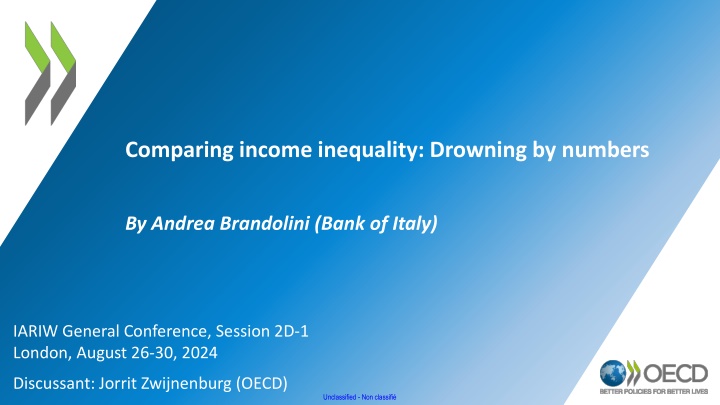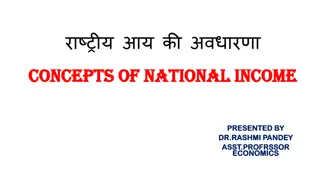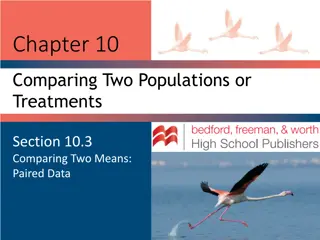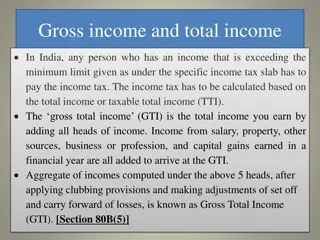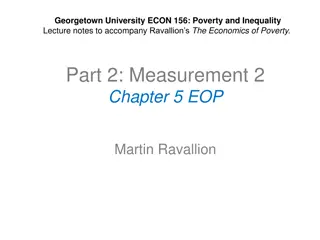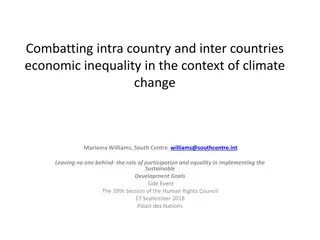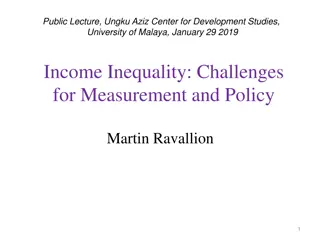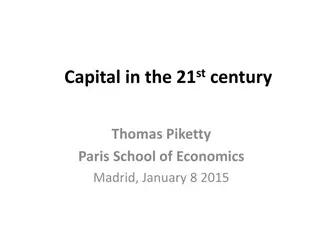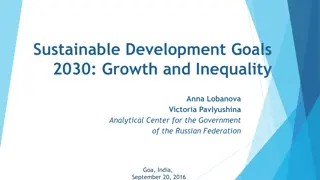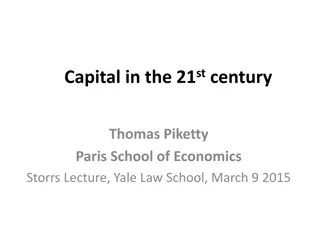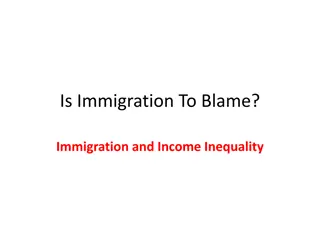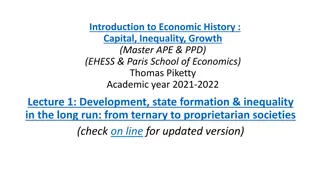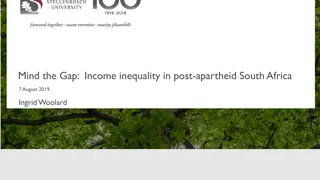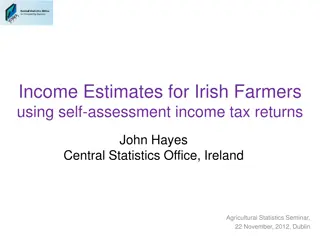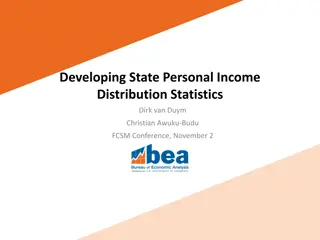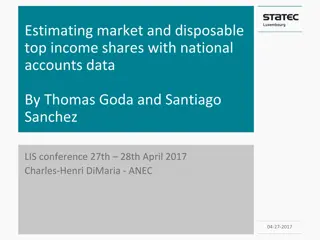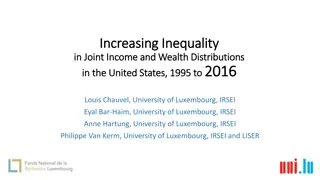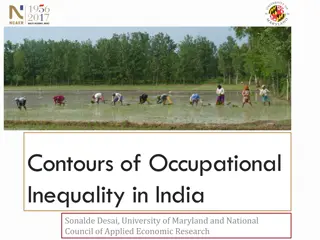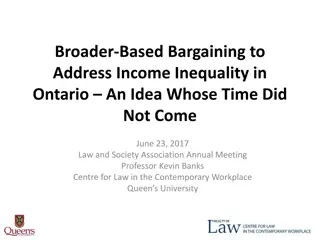Comparing Income Inequality: Advancements in Analysis
This paper by Andrea Brandolini explores the evolution of income inequality analysis over the past 30 years, focusing on data advancements, inconsistencies, and trends in selected countries. It discusses the challenges faced in comparing income distribution across nations and the improvements made in data quality, availability, and comparability through various research initiatives.
Download Presentation

Please find below an Image/Link to download the presentation.
The content on the website is provided AS IS for your information and personal use only. It may not be sold, licensed, or shared on other websites without obtaining consent from the author.If you encounter any issues during the download, it is possible that the publisher has removed the file from their server.
You are allowed to download the files provided on this website for personal or commercial use, subject to the condition that they are used lawfully. All files are the property of their respective owners.
The content on the website is provided AS IS for your information and personal use only. It may not be sold, licensed, or shared on other websites without obtaining consent from the author.
E N D
Presentation Transcript
Comparing income inequality: Drowning by numbers By Andrea Brandolini (Bank of Italy) IARIW General Conference, Session 2D-1 London, August 26-30, 2024 Discussant: Jorrit Zwijnenburg (OECD) Unclassified - Non classifi
Topic of the paper Growing interest in income inequality A lot of work has been done over the past decades to develop distributional information The paper examines the advancements in the analysis of income inequality over the last 30 years, providing an overview of the considerable improvements in the availability and quality of inequality data for cross-country analysis It focuses on results for Italy to assess (in)consistencies across most popular statistics It reflects on the evolution of income inequality in a few selected countries, reviewing the literature explaining its trends, changes and turning points Unclassified - Non classifi
Starting point: First four decades after WWII UN led the way in the collection of cross-country data on income distribution Work by the UN Economic Commission for Europe (1957) with tax-based data for Denmark, West Germany, the Netherlands, Sweden and the United Kingdom derived from original national sources Many compilations ever since, among others by UN agencies, ILO, World Bank, OECD, Individual scholars The initiatives varied considerably in terms of scope, country/year coverage, data documentation It was well understood that differences in sources and definitions affect data comparability The situation in early 1990s: Despite efforts, rather limited possibility of comparing inequality levels across countries or over time Unclassified - Non classifi
Data progress over the past 30 years Three lines of research radically changed the landscape: 1. Secondary data-sets assembled by drawing summary statistics from variety of existing sources, but with (generally) better documentation, selection, cleansing than in the past and including methods to adjust for data differences or to fill gaps Secondary data-sets exploiting rich but largely underused tax records; over time evolving into distributional national accounts Use of micro-data to overcome comparability problems, as pioneered by the Luxembourg Income Study (LIS), also including indirect derivations (i.e., databases leveraging off these datasets) 2. 3. Unclassified - Non classifi
1. Advancing and refining secondary data-sets World Bank (i.e., Deininger & Squire (1996)) drew together over 2,600 Ginis for 135 countries Identifying high quality subset of 700 observations for 115 countries Data widely used in academic research, but still comparability issues World Income Inequality Database (WIID) by UN University-WIDER and UNDP in late 1990s First version in 2000: 5,050 Ginis for 151 countries, assigning data labels reliable and less reliable , but no high quality , comparable subset Version 2023: 24,367 Ginis for 201 countries, with labels high , average , low and unknown ; supplemented with WIID Companion including standardized inequality series for 201 countries including 2,719 observations Standardized World Income Inequality Database (SWIID) Also based on WIID, but sourced from original data sources with aim to maximize comparability while maintaining widest possible country and time coverage Complex standardization routine with extensive imputation of missing values and smoothing to produce long and continuous time series Version 2023 includes Ginis for 199 countries with 6,173 observations Unclassified - Non classifi
2. Tax data Tax-based statistics have a long history in inequality analysis World Top Incomes Database (WTID) launched in 2011 Includes income shares of richest groups of taxpayers for more than 30 countries on the basis of tax records (with few exceptions), including alignment to external totals and Pareto interpolation for top income brackets Strengths: Length and density of time-series and better coverage of top earners Shortcomings: Definitions based on administrative rules; reference unit is taxpayer; breaks due to changes in tax legislations; tax avoidance practices; partial coverage World Wealth and Income Database (WID) launched in 2015 Successor of WTID, with an extension to wealth Unclassified - Non classifi
2. Towards distributional national accounts In 2017, the WID was renamed into World Inequality Database Conceptual change: Move from tax-based estimates of top pre-tax income share to Distributional National Accounts (DINA) It combines tax and administrative data, survey data, and national accounts to distribute whole national income (including all income flowing to other domestic sectors) among resident households OECD, Eurostat, ECB, national agencies distribute household income and wealth in line with national accounts (DNA) Allocation of specific items require assumptions Results have been challenged (see for example Zwijnenburg (2019) and Auten and Splinter (2024)) Unclassified - Non classifi
3. Building on microdata (1) Luxembourg Income Study (LIS) (launched in 1983) Database of microdata collected in household surveys, with ex-post, detailed harmonization As of July 2024, it contains information for over 50 countries Played fundamental role in driving cross-national harmonization (e.g., Canberra Handbook) Living Standards Measurement Study (LSMS) by World Bank launched mid-1980s Aims to improve household income data in low and middle-income countries via separately conducted studies, wit surveys sharing common features It currently includes 152 studies for 43 countries European Community Household Panel (ECHP) and EU Statistics on Income and Living Conditions (EU-SILC) European Household Finance and Consumption Survey (HFCS) Global Repository of Income Dynamics (GRID) Open-access database released in 2022, with data for 23 countries Harmonisation by applying single master code that applies steps uniformly across countries Unclassified - Non classifi
3. Building on microdata (2) Also, datasets with statistics directly computed from micro data: OECD Income Distribution Database (IDD) It contains indicators calculated by national agencies according to definitions and procedures set in detailed terms of reference As of October 2022, it includes Ginis for 45 countries, with oldest data for mid-1970s, updated on a rolling basis 2/3 times a year World Bank Poverty and Inequality Platform (PIP) It replaced the PovalNetwork and provides an interactive computational tool that offers users quick access to the World Bank s estimates of poverty and inequality It includes statistics for more than 160 economies around the world and allows users to perform their own calculations based on anonymized micro data Unclassified - Non classifi
Italy as a case study A lot of information is available nowadays but do they provide a consistent story? Next slides show available evidence from some databases discussed earlier Main question: Can we draw a coherent story on how inequality evolved in Italy since World War II? Unclassified - Non classifi
Disposable income - Original sources 50 Two main sources: SHIW: Bank of Italy s Survey of Household Income and Wealth EU-SILC (and predecessor ECHP) 47 44 41 Takeaways: SHIW and EU-SILC are broadly aligned But differences in year-by-year dynamics, partly justified by survey differences ECHP initially in line with SHIW, but quick depletion of panel Gini index (%) 38 Change in income definition 35 32 Bank of Italy (SHIW) Eurostat (EU-SILC) 29 Eurostat (ECHP) 26 1965 1970 1975 1980 1985 1990 1995 2000 2005 2010 2015 2020 Source: websites of Bank of Italy, Eurostat. Unclassified - Non classifi
Disposable income How does LIS compare? 50 Takeaways: Unsurprisingly, LIS very close to SHIW: same data except few minor items; but different equivalence scale But no adjustment in LIS for discontinuity in survey in 1987 47 44 41 Gini index (%) 38 LIS (Key Figures) Change in income definition 35 32 29 26 1965 1970 1975 1980 1985 1990 1995 2000 2005 2010 2015 2020 Source: websites of Bank of Italy, Eurostat, LIS. Unclassified - Non classifi
Disposable income How do OECD and WB compare? 50 Takeaways: WB (PIP) series are around 2 p.p. higher. Due to equivalence scales only (i.e., per capita vs. modified OECD)? IDD coincides with EU-SILC since 2004 PIP/IDD share SHIW dynamics before 2004, EU-SILC dynamics thereafter, reflecting change in source 47 44 41 Gini index (%) 38 World Bank (PIP) 35 32 29 OECD (IDD) 26 1965 1970 1975 Source: websites of Bank of Italy, Eurostat, OECD, World Bank. 1980 1985 1990 1995 2000 2005 2010 2015 2020 Unclassified - Non classifi
Disposable income WIID Companion and SWIID 50 Takeaways: WIID Companion series 3 p.p. higher than reference LIS series. Due to equivalence scale only (per capita vs. square root)? SWIID smooths out almost all variation: it hides critical junctures when inequality changes SWIID dramatic change pre- 1990 between two releases. Impact of standardisation routine? 47 UNU-WIDER (WIID Companion) 44 41 Gini index (%) 38 SWIID 9-4 35 32 SWIID 9-6 29 26 1965 1970 1975 1980 1985 1990 1995 2000 2005 2010 2015 2020 Source: websites of Bank of Italy, Eurostat, UNU-WIDER, SWIID. Unclassified - Non classifi
Disposable income WID and GRID 50 WID: unexplainable revision between 2023 and 2024 downloads Author also observes this for some other series 47 44 WID 2023 41 Takeaways: Rather different stories. Do they measure same phenomena? WID: distribution of national (not household) income, based on pervasive adjustments and imputations GRID: distribution of annual gross earnings among private (non-farm?) formal employees aged 25-55 Gini index (%) GRID 38 35 32 29 WID 2024 26 1965 1970 1975 1980 1985 1990 1995 2000 2005 2010 2015 2020 Source: websites of Bank of Italy, Eurostat, WID, GRID. Unclassified - Non classifi
Italy as a case study: Conclusions Can we draw a coherent story of how inequality varied in Italy since World War II? Answer: NO! Unclassified - Non classifi
To summarize Much improved understanding that data collection and manipulations (definitions, adjustments, etc.) matter Much richer portfolio of databases More survey/administrative sources collected since then IT advances/internet facilitate data construction/sharing But: False tension between survey and administrative data Long and continuous time series appealing for users, but at what cost? Ready-to-use compilations still insidious for inexpert users Need to understand underlying sources still there Unclassified - Non classifi
Discussion There is a lot of demand for distributional information and a lot of initiatives out there The paper provides a very useful overview of many initiatives It clearly specifies the challenges to arrive at comparable distributional results and to understand the differences between the various initiatives However, it is not clear how exhaustive the paper is: It could benefit from an explanation how initiatives have been selected (e.g., what criteria) and whether specific ones have been neglected Still work-in-progress: Some initiatives could benefit from further elaboration (e.g., EU-SILC, HFCS, IDD, PIP, DNA, DWA) The paper rightfully stresses the need for transparency regarding the concepts, methods and sources used in various initiatives It would be useful to provide an overview of similarities and differences between initiatives The paper could as a minimum discuss what characteristics would be relevant to reflect upon and possibly include an overview on (some of these) key characteristics for the various initiatives Unclassified - Non classifi
Discussion It would be helpful to obtain systematic insights in the characteristics of all the datasets: Income or wealth scope (e.g., household income, national income, ) Specific items included (e.g., imputed rent, investment income disbursements, ) Population scope (all resident persons, all resident adults, Unit of measurement (person, household, tax unit, ) Unit of analysis (person, household, consumption unit, ) Type of data collection (survey, fiscal data, other administrative) Stratification/thresholds/ Any adjustments applied to correct for missing parts of population, misreporting, See for example Zwijnenburg (2019) for a description of the main similarities and differences between DINA and DNA, and National Academies of Sciences, Engineering, and Medicine (2024) for an overview of similarities and differences for U.S. distributional results Unclassified - Non classifi
Example National Academies of Sciences, Engineering, and Medicine (2024) includes overviews of the main items included or excluded in income, consumption and wealth as used in various distributional databases for the U.S. The example on the right provides an overview for income Unclassified - Non classifi
Discussion All initiatives may have their own pros and cons Would a further collaboration across different fields help to improve the overall data situation and alignment of results? And, if so, how to best achieve this? The alignment to national accounts totals is already bringing together micro and macro experts Furthermore, various initiatives are bringing together experts from NSIs and academia to discuss differences in scope, methods, assumptions, etc. It may help to also discuss how to best present the data and accompanying metadata But perhaps more is needed? It may be useful to include some recommendations on how the community may best approach this Unclassified - Non classifi
THANK YOU For more information please contact: Jorrit.Zwijnenburg@oecd.org @OECD_Stat www.oecd.org/sdd www.stats.oecd.org Unclassified - Non classifi
